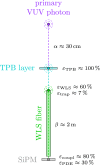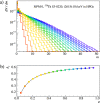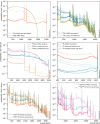Liquid argon light collection and veto modeling in GERDA Phase II
- PMID: 37122826
- PMCID: PMC10126063
- DOI: 10.1140/epjc/s10052-023-11354-9
Liquid argon light collection and veto modeling in GERDA Phase II
Abstract
The ability to detect liquid argon scintillation light from within a densely packed high-purity germanium detector array allowed the Gerda experiment to reach an exceptionally low background rate in the search for neutrinoless double beta decay of Ge. Proper modeling of the light propagation throughout the experimental setup, from any origin in the liquid argon volume to its eventual detection by the novel light read-out system, provides insight into the rejection capability and is a necessary ingredient to obtain robust background predictions. In this paper, we present a model of the Gerda liquid argon veto, as obtained by Monte Carlo simulations and constrained by calibration data, and highlight its application for background decomposition.
© The Author(s) 2023.
Figures








